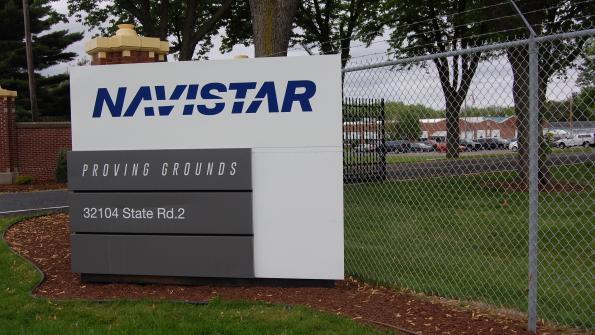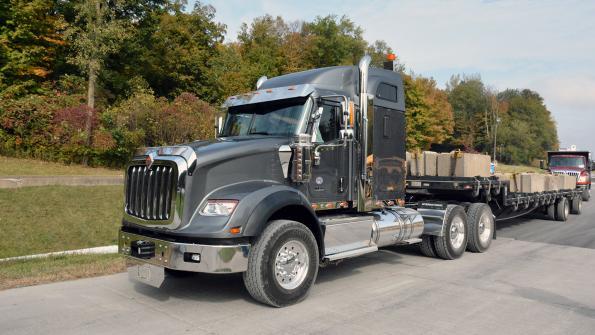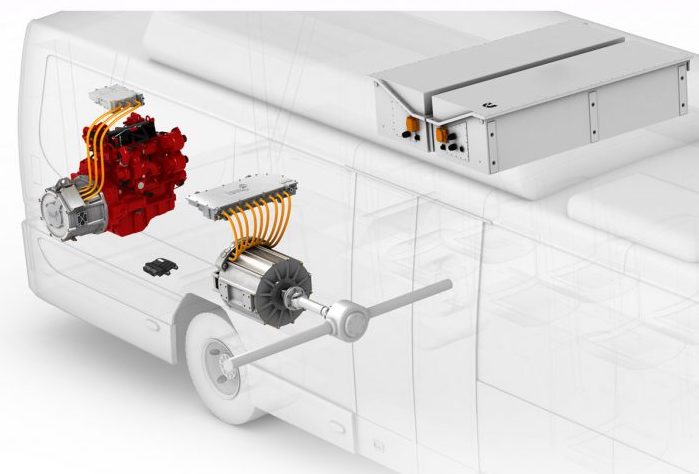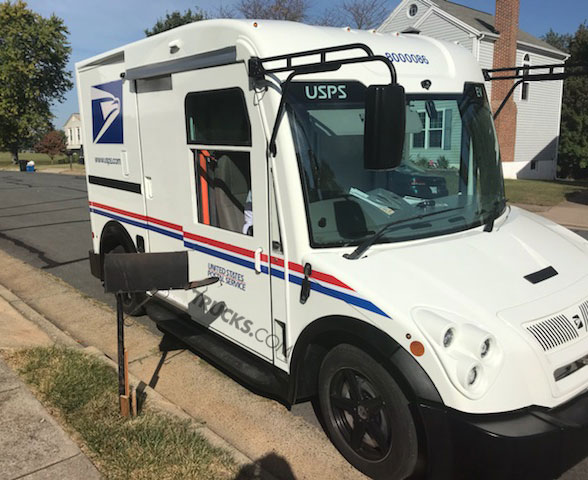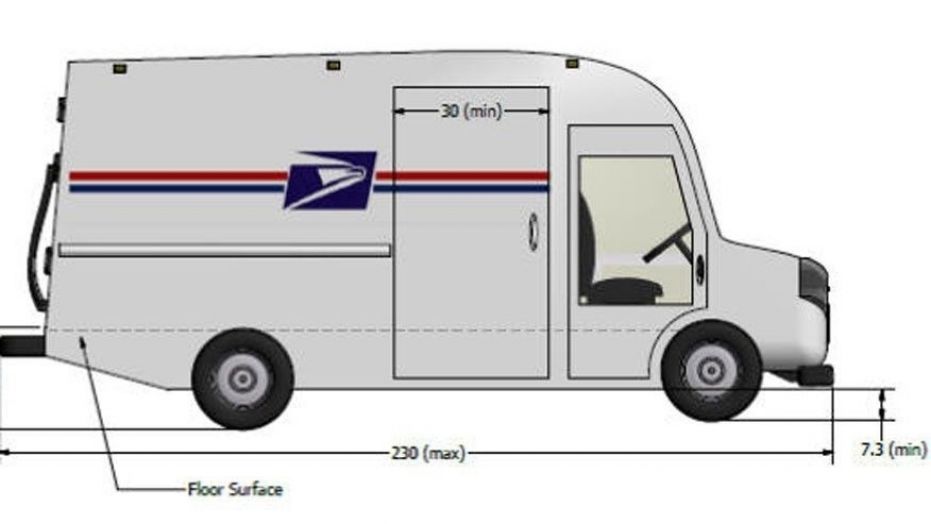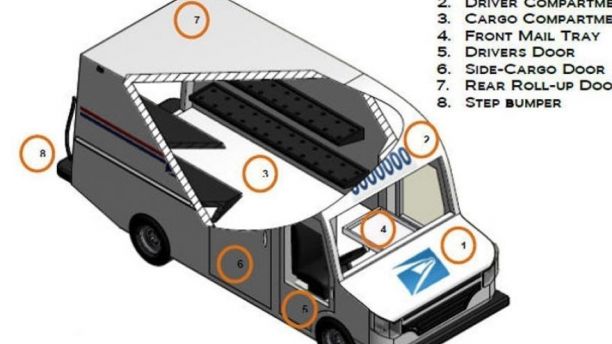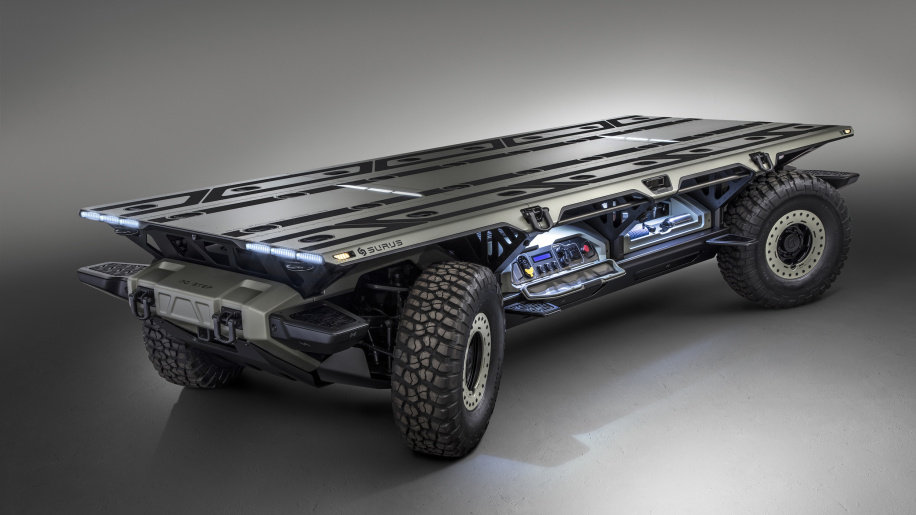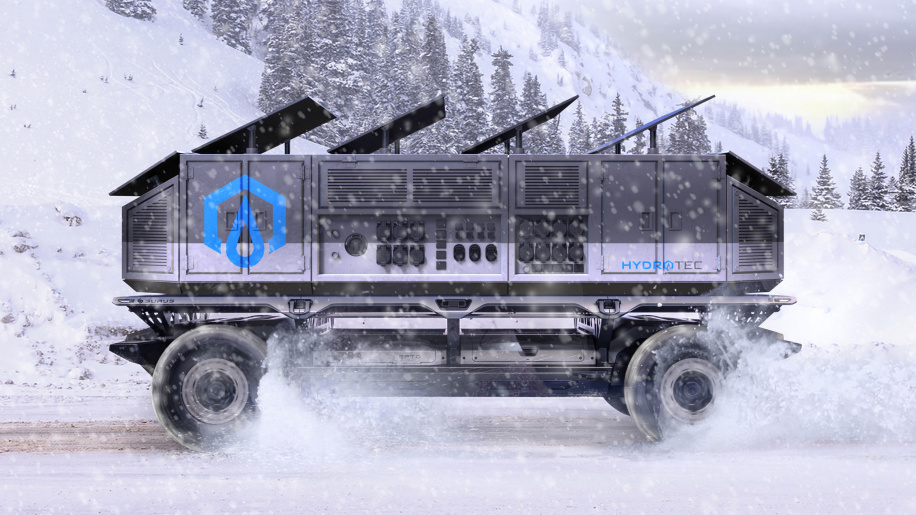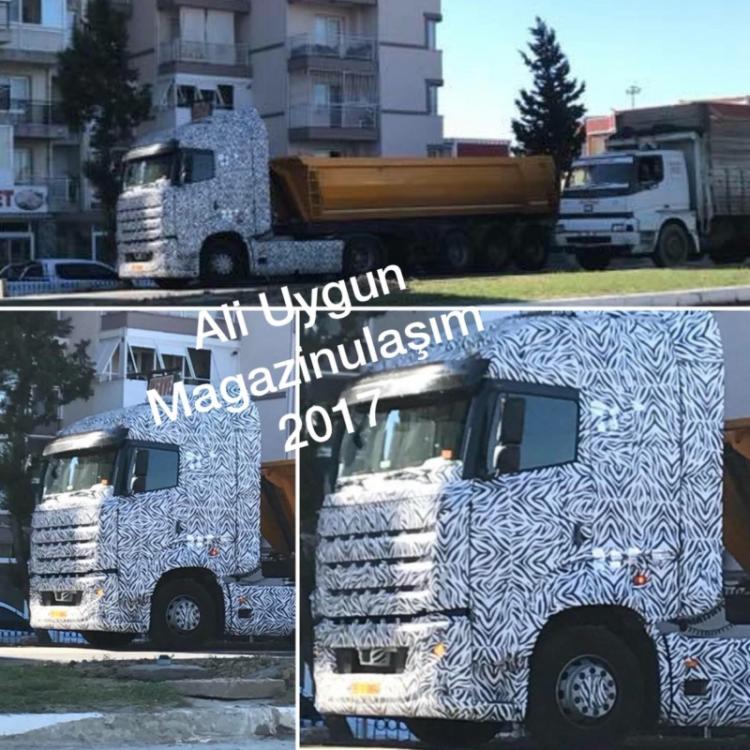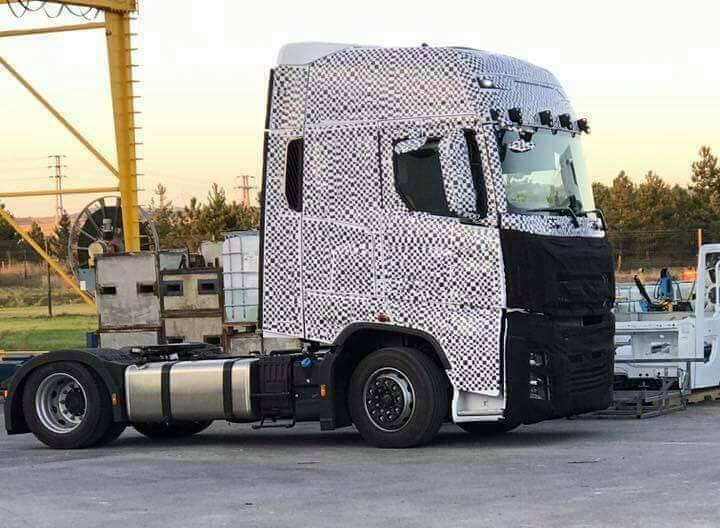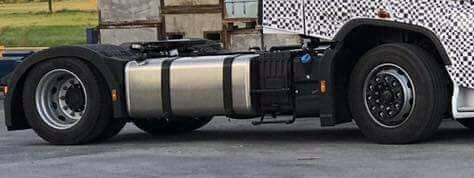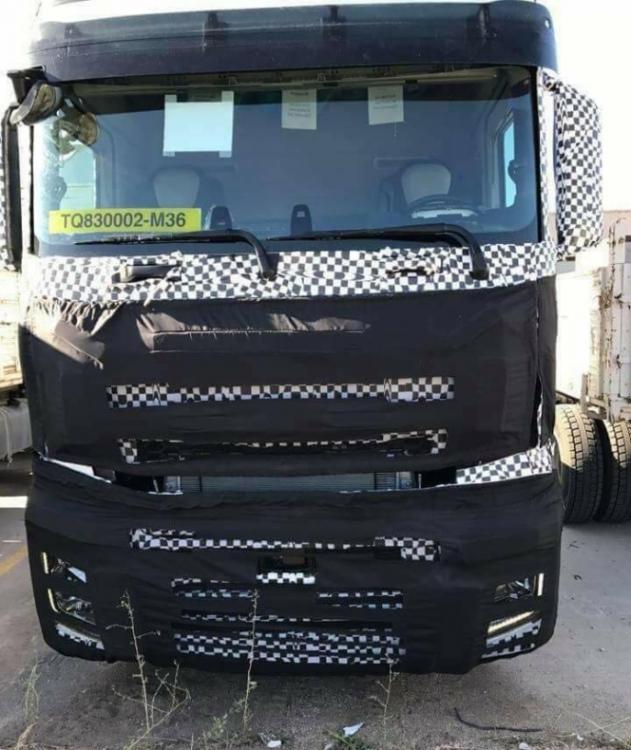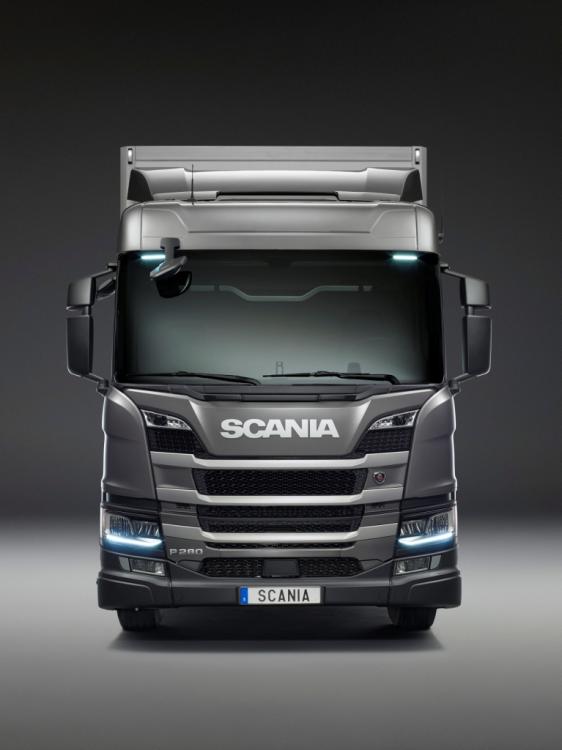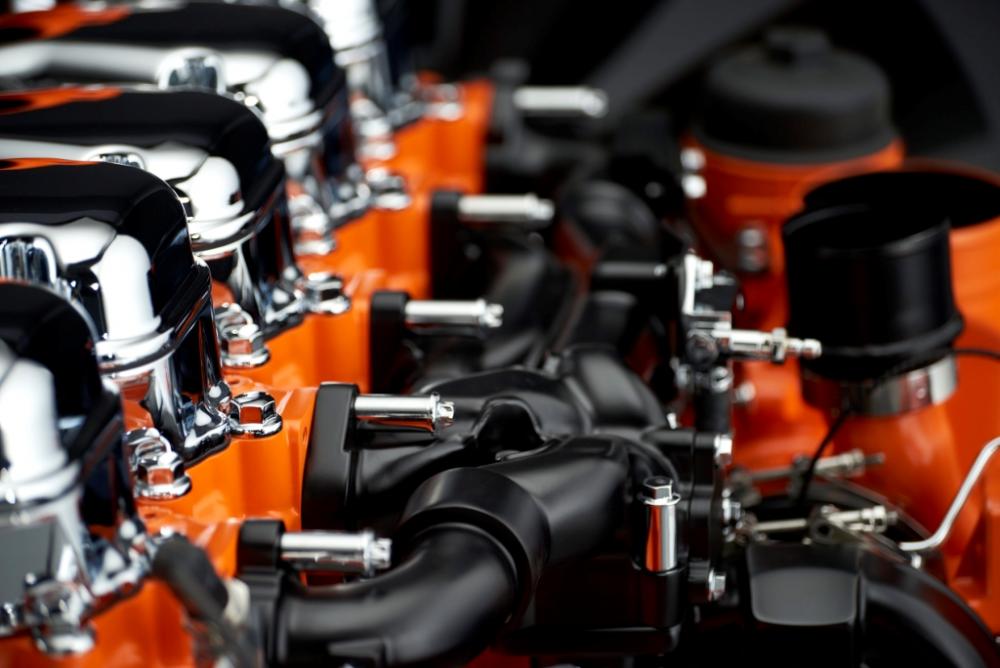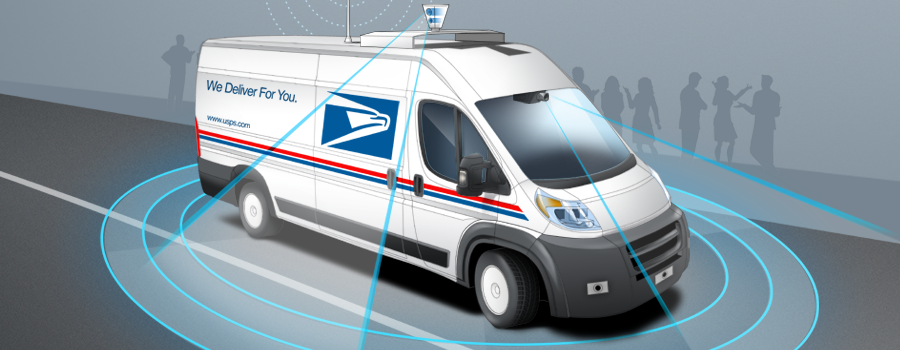
kscarbel2
Moderator-
Posts
18,895 -
Joined
-
Days Won
114
Content Type
Profiles
Forums
Gallery
Events
Blogs
BMT Wiki
Collections
Store
Everything posted by kscarbel2
-
Heavy Duty Trucking (HDT) / October 11, 2017 The first solar-powered transport refrigeration unit on a city delivery truck has been successfully tested over five months in California's San Joachin Valley, according to eNow, which supplied solar panels for the test. Compared to a diesel truck reefer unit, the "Rayfrigeration" reduced nitrous oxide by 98%, carbon dioxide by 86%, and particulate matter by 97%, said Jeff Flath, president & CEO of eNow. The 1,800-watt eNow solar system provided more than enough energy to maintain proper temperature throughout a typical day of opening and closing the doors while the refrigerated truck delivered fresh dairy products in California's summer heat. The Rayfrigeration system worked on a Johnson Truck Bodies refrigeration unit and an Emerson high-efficency compressor. The unit's cold plates and batteries are initially charged from utility power overnight, but while on a delivery route, power is provided by eNow's solar photovoltaic (PV) panels mounted on the truck's roof. The eNow team calculated that average emissions of CO2 were reduced from 2,525 lbs/week to 159 lbs. Nitrous Oxide emissions were reduced from 7162 grams to 1. This is after adjusting for the emissions from the power plant supplying grid electricity overnight; missions from solar are 0. In addition to eliminating emissions, the Rayfrigeration unit is projected to reduce operations costs by up to 90%, Flath said.. The savings are achieved through eliminating diesel fuel and maintenance costs, and an increased battery life thanks to consistent charge maintenance by eNow solar. "Rayfrigeration is an important step forward in reducing emissions while maintaining the highest levels of efficiency and customer satisfaction for companies delivering perishable goods," he said. "eNow's solar technology is powerful, reliable, and efficient, and provides emissions-free energy for critical tasks such as refrigeration. We are proud to be part of this important project." The San Joaquin Valley Air Pollution Control District funded the Rayfrigeration initiative through its Technology Advancement Program. Flath said eNow designs and sells solar-powered idle-reduction systems that reduce fuel and maintenance costs, save energy, and reduce emissions. More information is at www.enowenergy.com
-
Trump uses truckers to elevate tax reform push Neil Abt, Fleet Owner / October 11, 2017 President Trump promised a group of truckers during a speech in Pennsylvania that his plan to lower taxes will provide financial relief to their businesses and families. “America first means putting America’s truckers first,” said Trump, speaking in front of a tractor-trailer decorated with the slogans “I Love Trucks” and “Truckers for Tax Reform.” Trump made frequent references to the heroic and underappreciated role that truckers play in America’s economy. He promised to keep fuel prices low and advance a $1 billion infrastructure package “with a special focus on roadways and highways.” The central theme of the speech, however, was on his previously announced framework to modernize the “outdated, complex, and extremely burdensome tax code.” The result for truckers will be that “you will have so much money to spend,” he said. Among the highlighted items of the framework were reducing the number of tax brackets, lowering tax rates, boosting credits for child and elderly care, and making it easier for companies to bring back overseas profits. Trump also pledged that companies will be able to write-off 100% of new equipment in the same year it is purchased, and to cut the marginal tax rate for small and mid-sized businesses to the “lowest level in more than 80 years.” Trump recognized Kevin Burch, president of Jet Express and chairman of American Trucking Associations (ATA), who said he would “be able to invest in new equipment and additional training for workers” if tax legislation is passed. Additionally, Trump called for the permanent end to the estate tax, often referred to as the death tax. Trump cited Calvin Ewell, president of trucking fleet H.R. Ewell, as an example of a business owner who could struggle to pass down his family-owned business if that tax is not repealed. “While trucking sustains the vitality of the U.S. economy, we also carry a heavy tax burden, paying the highest corporate tax rate of any transportation mode,” said ATA president and CEO Chris Spear. “That is why we joined President Trump at today’s event, in support of his plan to reform our tax code. We urge Congress to follow the president’s lead and pass tax reform by year’s end." One day before Trump’s speech, White House press secretary Sarah Sanders confirmed during her daily briefing there was not yet any actual tax reform legislation. “Our priorities remain the same. But the final piece of legislation hasn’t been finalized, so this is a time of negotiation. But the principles and the priorities that we’ve laid out are not up for negotiation,” she said. Ahead of the speech, Daseke Inc. CEO Don Daseke told Fleet Owner he was optimistic Trump would be able to lower tax rates, bring back overseas corporate profits, and boost economic growth at home. “We, like all business executives, are in favor of all of those things,” said Daseke, whose company is a flatbed and specialized freight specialist. In response to a question, Daseke said he believes Trump’s tax plan will benefit all truck drivers, including the 1,000 owner-operators his company utilizes. “If it is good for the American economy, it is good for largest trucking company and the smallest trucking company,” he said of the tax proposal. He also suggested that including truckers as part of the tax speech would help keep the focus on the desperate need for a new federal infrastructure plan.
-
Michael Catarevas, Fleet Owner / October 11, 2017 Adapting VW’s products for the U.S. market isn’t as challenging as Navistar originally thought. At a Navistar ride and drive event held at its proving grounds in New Carlisle, IN, this week, company executives told Fleet Owner that the partnership agreement with Volkswagen Truck & Bus is off to a “robust start,” with both meshing well from the get-go. “You would think there would be a lot of cultural differences, but surprisingly there’s not much,” said David Majors, vice president of product development. “I think the lines have been set up in the contract so we know what our jobs are, and now it’s just about executing, so there’s not a lot of ‘our stuff is better than your stuff,’” he explained. “It’s more ‘this is what we’re going to use and this is the direction we’re going to go.’ Adapting their products for the U.S. market isn’t as challenging as we originally thought, so it’s moving along pretty well and we’re confident we’re going to have something good.” Navistar announced at the North American Commercial Vehicle (NACV) show in Atlanta that it plans to develop fully integrated diesel big bore powertrains in conjunction with VW for the North American market in 2021. VW last year agreed to purchase a 16.94% stake in Navistar– a deal that formally closed back in March – and at the NACV show, the companies also said they will develop an electric-powered, medium-duty vehicle for the U.S. and Canada in late 2019 or early 2020. “The Volkswagen alliance will do two things for us,” explained Denny Mooney, Navistar’s senior vice president of global product development. “Number one, it opens us up to a lot of European technologies we hadn’t had access to. I’ve met with counterparts from Scania and MAN, the two companies that make up the VW heavy truck business, so we’re already working on new technologies for the next few years.” He added that Navistar’s 13-liter engine is a version of the MAN engine and that “bigger powertrain opportunities” will soon open up, giving Navistar more scale and technology. “European technology standards aren’t much different than U.S. standards, so a lot of the emissions technology is common,” Mooney noted. “The development cost you can spread amongst multiple companies. That lowers our cost and makes our products more affordable.” Steve Gilligan, Navistar’s vice president of product and vocational marketing, explained that there were further benefits from the alliance with VW than simply co-manufacturing trucks. “The first place we’ve seen a significant change is from the supply side, because obviously they’re a global company,” he said. “They bring a global scale, and so our purchasing people have had a lot of meetings looking for opportunities.” Whether that manifests itself in anything from tires and collision mitigation systems to cameras and lighting technology, all of those areas are “open right now” for review with a lot of opportunities emerging, Gilligan added. “Think of the global scale they bring just on camera technology versus our scale on trucks,” he continued. “The whole truck market is going to be 300,000 [units] next year. Even on medium-duty trucks, more and more customers are asking for things like cameras that face down for security and a visibility standpoint. So we’re looking for things that we can leverage, possibly taking the technology they’re using in the passenger car market and migrating it over to the light and medium truck market as well.” Mooney concluded by relating the opportunities for Navistar engineers to grow is tremendous. “It’s an exciting time,” he said. “A lot of our younger engineers want to get a European experience. And we’ve had Scania and MAN engineers to our proving grounds. We love their trucks and they love our trucks, and so it’s great for the engineers.” .
-
Navistar showcases new and ‘refreshed’ trucks Michael Catarevas, Fleet Owner / October 11, 2017 Ride and drive at Indiana proving grounds spotlights engine improvements as well. NEW CARLISLE, IN. It was a virtual and extended rush hour at Navistar’s 675-acre proving grounds this week as the OEM showcased a variety of its brand new and recently upgraded truck and tractor models during a special ride and drive event for journalists. The facility’s three-mile, three-lane oval, and its fearsome durability severe service route challenged all-new International HV Series utility, dump and day cab models, alongside upgraded versions of the OEM’s HX Series trucks, introduced back in February of 2016, plus the LT linehaul and RH regional model tractors, introduced in September of 2016 and April of 2017, respectively. Navistar executives were very bullish on what the future holds where those trucks are concerned and especially concerning the new partnership with Volkswagen – cemented just this past March – which will provide additional engineering know-how to keep making them better. “These products are about putting the driver first,” explained Denny Mooney, Navistar’s senior vice president of global product development. “We know there’s a driver shortage in the industry and we have really tried to make these trucks what they want to drive. When we talk to our big fleet customers they tell us, ‘if our drivers don’t want to drive your trucks, we’re not going to buy your trucks.’ You can have great fuel economy, you can have great attributes, but at the end of the day, drivers have to want to drive them.” For example, when Navistar began upgrading its LT Series tractor, Mooney said the OEM held a lot of driver clinics to find what they liked or didn’t like about the truck. “What I like as an engineer might not be what drivers like,” he stressed. Mooney also pointed to new technology improvements designed to appeal to drivers and fleets alike. “New [air] disc brakes fit into this driver-first philosophy,” he said. “The trucks are easier to drive. Disc brakes aren’t as ‘grabby’ as the old drum brakes. The life of a disc brake is longer, and some of the fleets are starting to realize it. Our disc brake penetration has doubled in the last two years. We made them standard on the LT in June of this year.” He emphasized that demand for collision mitigation systems are starting to take off as well. “We made it standard on the LT when we launched it last year,” Mooney said. “Predictive cruise control is another technology starting to take hold. It looks ahead two to three miles and judges the topography of the road, deciding what speed and shifts to be in, and there’s real-world fuel economy improvement.” Navistar also showcased its new 12.4-liter A26 engine in two tractors for test drives – one cranking out 450 hp and 1,700 lb.-ft. of torque in a 6x4 LT Series tractor equipped with a 56-in. sleeper and the other rated at 400 hp and generating 1,750 lb.-ft. of torque in a 6x4 RH daycab model. The company said the A26 is 5% more fuel-efficient than its previous 12.4-liter unit, with oil change intervals increased up to 70,000 miles. “We put a new turbocharger on it,” noted Mooney. “It’s a single turbo where we used to have a twin turbo. It’s a simpler turbo, a VGT [variable geometry turbocharger]. It’s got low-end and high-end power.” The whole philosophy, he explained, is to simplify the engine – make it easier to service, less complex, and with less weight. “It’s the lightest big bore engine in the market. It’s also a great vocational engine,” Mooney added. “Those types of trucks love light weight, like cement mixers, etc.” David Majors, Navistar vice president of product development, told Fleet Owner that part of the OEM’s new design philosophy is to “use a lot of the same switches, dials and gauges clustered from the LT launch, to maximize the usage and volume of those parts.” That way, fleets that operate multiple vehicles will have “a very common interior” for them to use, he added. Heating, ventilation and air conditioning or “HVAC” upgrades also proved to be a major engineering focal point, Majors explained. “We’ve improved the air conditioning units, with five vents, so if you have a bench seat the center passenger is comfortable,” he said. “The HVAC system has been completely redesigned so the defrost performance is best in class.” Steve Gilligan, Navistar’s vice president of product and vocational marketing, said the company is particularly excited about its new HV trucks. “We led with the LT, followed with the RH, and now the HV, and in a few months there will be the MVs,” he said. “So we’re on a plan to update every model.” From an economic standpoint, Gilligan said Navistar is projecting a “really strong” construction market going forward. “We have seen quite a bit of growth in daycab, seen it accelerate faster than sleeper, and we’re also seeing construction and off-highway growing faster as well,” he pointed out. “And that’s before any sort of stimulus plans. It all bodes well for 2018.” Jeff Sass, Navistar’s senior vice president for North America truck sales and marketing, expressed further confidence going forward regarding the overall volume for truck sales. “Medium-duty is up three-ish percent [in sales], and Class 8s up half a point year-over-year,” he said. “I see the economy being strong in 2018, freight rates going up and it being a big year for manufacturing. Fleets say they have more loads than drivers. They tell me they’ll buy every truck we can sell that has a driver in it.” .
-
Bloomberg / October 11, 2017 Volkswagen AG is flanking its push into electric cars with plans to roll out battery-powered commercial vehicles targeted at urban areas as growing public concerns about air quality boost demand. The Volkswagen Truck & Bus division will invest 1.4 billion euros ($1.7 billion) in new technology including electric drivetrains, autonomous systems and cloud-based software, Andreas Renschler, head of the unit, said Oct. 11 in an interview in Hamburg. The German company’s U.S. affiliate Navistar International Corp. will adopt some of the systems, while the carmaker’s MAN and Scania nameplates will both deliver wholly electric buses next year to European cities, adding to bio-diesel, hybrid systems and natural-gas line-ups. “We believe in a wide range of alternative powertrains and fuels, depending on local availability, social and local demand and customer requirements,” Renschler said at a press event. “Therefore it is crucial that policy makers adopt a technology-neutral approach” in any regulations. Electric trucks for local deliveries will probably exceed a 5% market share by 2025, according to Renschler. That compares to a forecast of about 25% for battery-powered cars. Commercial-vehicle manufacturers have been slow to develop electric models as loads are heavier and they serve a wider range of industries. Regulatory Differences Complicating matters is that trucks already vary significantly across the globe because of differences in regulations, making it difficult to build vehicles in large enough volumes to generate economies of scale. While in the aftermath of Volkswagen’s emissions-cheating scandal, some municipalities are looking at banning diesel engines to reduce air pollution. German competitor Daimler AG, the world’s largest commercial-vehicle producer and Renschler’s former employer, has stepped up development of engines including fully electric and hybrid versions as well as digital services to defend its lead. Volkswagen is also facing new rivals such as Tesla Inc., which is unveiling of a battery-powered semi-truck on Nov. 16. Better battery technology will be key to making electric trucks more attractive by lowering operation costs, Renschler said. In addition to higher prices for the systems and recharging challenges, the power packs “are heavy and room-stealing,” reducing the capacity for carrying loads, Renschler said. “With city buses, we are just hitting the break-even point compared to conventional solutions,” Renschler said. “Electric distribution trucks are expected to turn positive in 2020-25,” while battery-powered long-haul heavy vehicles will be “late” in turning a profit for their owners. Autonomous Technology VW Truck & Bus’s autonomous-driving technology is focused on closed environments, like snow plows at airports or transport shuttles on set routes in parking lots or factories. VW plans to be ready for commercial production of the models within two years. Engineers are already working with customers to refine technology and gain experience. “The autonomous Scania mining truck standing outside of this building is ready to be shipped to the first customer overseas after this event,” Renschler said. “This truck is not a vision. It’s real stuff, here and now.” Success with those models, as well as services including new software to efficiently manage cargo, will determine whether VW’s push to forge a global truckmaking powerhouse with an operating return on sales averaging 9% will gain traction. Renschler said VW is keeping all options open to expand the business, including a possible share sale. He’s also looking at increasing the 25% stake in China’s Sinotruk Hong Kong Ltd. that MAN holds as well as widening cooperation with GAZ PJSC in Russia and Navistar in the U.S., where Daimler’s Freightliner brand is the market leader.
-
Trump Rallies Truckers to Support Overhaul of Tax Code Transport Topics / October 11, 2017 MIDDDLETOWN, Pa. — President Donald Trump discussed the various benefits trucking companies will reap from his tax plan before an audience of industry executives at an Air National Guard airplane hangar outside of Harrisburg on Oct. 11. Tax reform was one of the pillars on which Trump built his campaign. He announced his long-awaited tax plan Sept. 27. One of the chief tenets involves the abolishment of the estate tax, also known as the death tax. That tax is levied on the transfer of the estate of a deceased person. “To make the tax system simple and fair, we are going to protect thousands of family businesses by ending the crushing estate tax,” Trump said. “We’re going to protect small business owners. The strength of our nation is dependent on the strength of our families.” Representatives from trucking companies, many of which are family-owned, expressed enthusiasm at the prospect of ending the estate tax. John Summers, who along with his sister and cousin make up the third-generation owners of Summers Trucking, said he plans to pass his company to a fourth generation of family members. Summers Trucking is based in Ephrata, Pa., which is about 65 miles west of Philadelphia. The company’s fleet is consists of 75 trucks and 500 trailers. Summers said fewer taxes will provide opportunities to reinvest in training that will help rectify the industrywide shortage of truck drivers. According to the American Transportation Research Institute, the industry was short 48,000 drivers in 2015. “We have an opportunity now like we’ve never had,” Summers said. “I need to be able to reinvest that money back into my trucks. We need to keep building.” During his speech, Trump called out Calvin Ewell, president of H.R. Ewell, a family-owned liquid bulk carrier based in East Earl, Pa., that was founded 1946. The company was founded by Ewell’s father, and Ewell said he plans to pass the company along to his son, Steven. The elder Ewell said abolishing the estate tax is “way overdue.” “Abolishing the death tax is a great thing to help the family business to keep going,” Steven Ewell said. Trump’s tax plan also proposes cutting the top individual rate to 35% and leaves Congress to decide whether to create a higher bracket for those at the top of the income scale. It also proposes a top corporate tax rate of 20%, down from 35%. Trump previously rallied for a 15% corporate tax rate. According to Trump, the plan caps the top tax rate at 25% for American manufacturers that file taxes as sole proprietors, S corporations or partnerships. Also, for the next five years, the framework allows companies to fully write off the cost of new equipment in the year they buy it. Kevin Burch, president of Jet Express and chairman of American Trucking Associations, said he plans to invest in new equipment and training for drivers and technicians. ATA President Chris Spear, who attended the speech in support of the plan, said ATA representatives will prowl the halls of Congress to rally support for the framework. Spear said many ATA members will benefit from the “fundamental” cuts laid out in the plan. Of ATA members, 97.3% have 20 or fewer trucks, he said. “We’re the backbone. He understands what tax reform will do not only for our industry but for our country. Our job is to go and get this bill done,” Spear said. “We will carry the water on this. We’re going to be working it hard on Capitol Hill to get this done.” Besides members of the trucking industry, representatives from the Pennsylvania Manufacturing Association, the Pennsylvania chapter of the National Federation of Independent Business, the Harrisburg Regional Chamber of Commerce and local government agencies attended the event. Harrisburg marks the latest stop on which Trump discussed tax reform. He also spoke about the plan Sept. 29 at the National Association of Manufacturers’ annual board meeting in Washington. Trump praised the trucking industry, stressing its importance to the American economy. The specifics of his $1 trillion infrastructure plan have yet to be revealed. “We truly admire you. You are our heroes,” Trump said. “American trucks will glide along our highways. We will build this future together.” .
-
TM4 introduces new motor/generator for heavy-duty hybrid market
kscarbel2 replied to kscarbel2's topic in Trucking News
TM4 and Cummins jointly developing range-extended electric plug-in powertrain for Class 7/8 buses Green Car Congress / May 11, 2017 TM4 and Cummins are jointly developing a plug-in hybrid powertrain for Class 7/8 transit buses that can reduce fuel consumption by at least 50% compared to conventional hybrid buses. The project aims to provide transit authorities with a flexible, more efficient drivetrain and a longer range zero-tailpipe-emission capability for inner-city routes. The range-extended electric drive system comprises a gen-set (Cummins’ Euro 2019 B4.5 diesel engine coupled with TM4’s LSG130 electric generator); an external 450 kW ultrafast charging infrastructure; a power collector; a 111 kWh onboard Li-ion battery; a TM4 SUMO electric motor directly connected to the differential; a small fuel tank and power electronics. The Cummins B4.5 is a 4-cylinder, Euro 6-compliant on-road diesel engine that uses a combination of cooled exhaust gas re-circulation (EGR) and variable geometry turbocharging (VGT) on the engine allied to a new aftertreatment system incorporating particulate filtration (DPF) with selective catalytic reduction (SCR). It has become one of the most widely used engines for lower-carbon diesel electric hybrid buses across the UK and Europe. It is available up to 210ps for trucks and buses, with a strong peak torque of 760 N·m. TM4 is a leader in electric powertrain development and equipped 5,000 buses in China last year. TM4’s expertise and real-road experience will be instrumental in developing an optimized powertrain for plug-in transit buses. The TM4 LSG130 generator puts out 135 kW of continuous power at an operating speed of 3400 rpm. Developed for performance and durability, TM4 SUMO drive systems are optimized for medium- and heavy-duty electric and hybrid vehicles such as 6-18 meter buses, delivery trucks, shuttles, and tow tractors. Direct drive operation reduces powertrain complexity and cost, and yields more than 10% efficiency gains throughout the driving cycle, representing an equivalent gain in battery usage, according to the company. TM4’s permanent magnet electric motors are based on an external rotor topology, delivering higher power and torque densities as well as increased long-term reliability. Cummins researchers will optimize the powertrain by selecting the engine with the best architecture to use as an electric commercial vehicle range extender, using the engine to manage the charge level of the all-electric drive battery pack. Our goal is to offer a system that can achieve 35 km EV range and benefit from the 450 kW fast charging infrastructure to recharge in less than 5 min. The range extender allows for peace of mind and significant flexibility. We are honored to be partnering with Cummins and hope to bring this product to market in the near future. —Robert Baril, Managing Director of TM4 The range extender will be integrated, using advanced vehicle controls, with the electrified powertrain and other applicable technologies. The close integration and control of the electrified powertrain with an appropriately selected engine is critically important to developing a plug-in hybrid electric vehicle system. We believe that through the team's efforts we can become a significant player in electrification of commercial vehicles by providing complete systems to benefit our global customers. —Wayne Eckerle, VP, Cummins Research and Technology The plug-in hybrid powertrain will be shown for the first time at UITP, taking place in Montréal next week. . -
Green Car Congress / October 11, 2017 TM4 is expanding its SUMO family of electric powertrains (earlier post) with the introduction of the new SUMO HP line which is dedicated to high-power applications. As part of this new line, TM4 is launching the SUMO HP HV900, a new motor/generator and inverter combination for the commercial heavy-duty market. The SUMO HP HV900 is currently being used as part of the plug-in hybrid powertrain system being developed in a joint effort with Cummins that was announced in May. (Earlier post.) This new motor/generator will be shown at Busworld Kortrijk, taking place from 20-25 October 2017 in Kortrijk, Belgium. The SUMO HP HV900 offers 190 kW of continuous power and 915 N·m (675 lb-ft) of torque in a casing of only 200 mm in length. It was purposely developed for series and parallel-hybrid configurations and can be coupled with diesel engines, multi-speed gearboxes or integrated to axles for ultra-low floor buses. TM4 offers this new motor/generator with its well-proven 3-phase CO150 inverter, already used in thousands of vehicles worldwide. The efficiency of the system reaches 95% and has been developed to match the efficiency of a diesel engine, which is instrumental to optimize fuel savings. In a series-hybrid, the combined use of the electric traction system, the optimized gen-set and electrified accessories can result in a minimum of 50% in fuel economy compared to a conventional diesel-powered vehicle. Several applications relying on long range and low downtime are not yet suitable for complete battery-based operation without significant infrastructure or battery technological breakthrough. Therefore, our offering of a compact and efficient gen-set is a valuable asset to enabling electrification in urban delivery trucks, inter-city buses and even long-haul trucks. —Eric Azeroual, Sales and Customer Service Director at TM4 TM4 introduced its SUMO family of powertrains five years ago to assist its customers with cost-effective vehicle electrification. The SUMO HP line is the latest member of this family that already includes the SUMO MD line, dedicated to medium-duty vehicle applications and the SUMO HD line, targeted at heavy-duty vehicle applications. Earlier this year, TM4 repositioned its operations to focus on motors for heavy vehicles and buses. It is a market with strong growth potential where TM4 has already enjoyed significant success. Its joint venture Prestolite Electric Propulsion Systems (PEPS), for instance, has seen its share of the Chinese market climb from 0.4% in 2015 to 4% in 2016, with a 7% to 8% increase forecast for this year. TM4’s new product development will concentrate on SUMO motors, while operations relating to the light-vehicle segment will be scaled back. The company will nevertheless remain alert to any new mass production opportunities in the automotive industry. TM4 is a wholly-owned subsidiary of government-owned public utility Hydro-Québec.
-
. .
-
Trump could envision U.S. trade deal with Canada without Mexico Reuters / October 11, 2017 WASHINGTON -- President Donald Trump said on Wednesday he would be open to a bilateral trade pact with Canada if a deal cannot be reached with Mexico to substantially revise the North American Free Trade Agreement. Asked by a reporter if he could envision maintaining free trade with Canada if NAFTA talks sour with Mexico, Trump said: "Oh sure, absolutely. It's possible we won't be able to reach a deal with one or the other, but in the meantime we'll make a deal with one." He spoke at the White House alongside Canadian Prime Minister Justin Trudeau, on a visit to try to convince the U.S. leader of NAFTA's merits as a new round of renegotiations began near Washington. Asked about Trump's comments at a news conference later, Trudeau said he was still optimistic about the chances of modernizing the 1994 trade pact. "I continue to believe in NAFTA ... so saying, we are ready for anything, and we will continue to work diligently to protect Canadian interests,” Trudeau said. Trudeau also said that Canada was well aware of Trump's unpredictability. "That is certainly something that we are very much aware of and very braced for and conscious of but at the same time, Canadians expect us to work in a thoughtful meaningful way towards getting a good deal." The U.S. Chamber of Commerce on Tuesday accused Trump's administration of trying to sabotage the talks with "poison pill proposals," including demands for more favorable treatment for the U.S. side on car production, and a "sunset clause" to force regular negotiations. In his appearance with Trudeau, Trump said "we'll see what happens" when asked whether NAFTA was doomed. "It's possible we won't be able to make a deal, and it's possible that we will," he said. "We'll see if we can do the kind of changes that we need. We have to protect our workers, and in all fairness, the prime minister wants to protect Canada and his people also." U.S. Commerce Secretary Wilbur Ross, one of Trump's top trade advisers, downplayed the chances that a NAFTA termination would become necessary. "We don't hope it will, we don't desire that it will, we don't believe that it will, but it is at least a conceptual possibility as we go forward," Ross said. But U.S. and Mexican corporate chief executives gathered in Mexico City said they would be better off with no NAFTA than be saddled with a "bad agreement." Aggressive proposals Trade experts say the NAFTA talks are likely to stall in the face of aggressive U.S. attempts to sharply increase content requirements for autos and auto parts. People briefed on U.S. proposals to be presented this week said Washington is seeking to sharply lift North American content threshold in light-vehicle manufacturing. The proposals call for North American content overall to rise to 85 percent from the current 62.5 percent. In addition, the United States wants to add a new 50-percent U.S.-specific content requirement, something that was not in the earlier agreements. "These will be met with widespread opposition from Canada and Mexico. I think it's just a bridge too far," said Wendy Cutler, the Asia Society's Washington policy director and former chief U.S. negotiator for the Trans-Pacific Partnership trade deal canceled by Trump. The U.S. side sees strengthening the rules of origin for the auto industry as a way to bring back some auto parts production, including electronics, from Asia. But Mexico strongly opposes a U.S.-specific content requirement, which would limit the growth of its own auto industry. The difficult issue of rules of origin will be addressed mostly at the end of the current talks, according to a schedule obtained by Reuters. The negotiations were extended on Wednesday by two days to Oct 17. Other U.S. proposals opposed by Canada, Mexico and U.S. business interests include the five-year sunset provision, radical changes to NAFTA's dispute arbitration systems, changes to intellectual property provisions and new protections for U.S. seasonal produce growers. U.S. Trade Representative Robert Lighthizer said on Wednesday the three nations had completed their negotiations on company competition policy, reaching an agreement that goes beyond previous U.S. trade deals to ensure "certain rights and transparency under each nation's competition laws."
-
2018 Jeep Wrangler to offer optional 368-hp 4-cylinder engine
kscarbel2 replied to kscarbel2's topic in Odds and Ends
FCA rescinds 368-hp rating on 2018 Jeep Wrangler's 4-cylinder Automotive News / October 11, 2017 Fiat Chrysler has rescinded the information it filed with the National Highway Traffic Safety Administration concerning the power output of the 2.0-liter turbocharged I-4 engine it plans to put in some versions of the upcoming 2018 Jeep Wrangler. Previously, FCA had told NHTSA in a filing first noticed by thetruthaboutcars.com that the turbo four-banger would produce an astonishing 368 hp. But after that information became public, FCA this week refiled its notice with NHTSA, removing the 368-hp rating and changing it to "NR" (not rated). The website gets credit as well for noticing the update. Was the 368-hp rating an early leak, a typographical error, or just a big whoops? FCA declined to comment on the change. However, a 368-hp I-4 would be right near the current peak of the all-important power-rating-per-liter of displacement that global automakers have been able to pull from their 2.0-liter engines. Such an engine would be counterintuitive in a heavy, boxy vehicle like the Wrangler, which has previously thrived on the low-end torque available from its current 285-hp 3.6-liter V-6. Production of the JL Wrangler is scheduled to begin in November on a newly built line at FCA's Toledo Assembly Complex in Ohio. -
Volvo introduces new Mack “Anthem” on-highway tractor
kscarbel2 replied to kscarbel2's topic in Trucking News
Paul, between the two, I personally feel that only the Trident is an attractive looking truck. There is a need for aerodynamic trucks in many applications, but they can be designed aesthetically to have a reasonable appearance. Volvo's new Anthem is a done-on-the-cheap rehash of the Pinnacle, which was a 2006 Volvo done-on-the-cheap rehash of the Vision, which was a 1999 second generation rehash of the CH introduced in 1988, which was first penned in 1983. The "all-new" Mack Anthem? Not. The headlamp modules remind me of those on the Griswold's Wagon Queen Family Truckster station wagon in the movie "Vacation". The grille styling reminds me of a Panasonic "Toughbook" laptop. “We have helped build America [Volvo?],” proclaimed Mack president Denny Slagle, referring to the company’s 117-year heritage. “We have arrived at an important milestone. This launch should be seen as a new day, a new start, a game changer for our [America's or Sweden's?] beloved Mack brand.” (https://www.todaystrucking.com/mack-sings-praises-of-new-anthem) Sweden's Volvo stamps an American flag next to the Anthem name on the truck’s badge. Strange. Do Toyota or Honda stamp an American flag on their cars? Call a spade a spade. -
There's something personal about Otosan for Bill Ford, I believe relating to his family's long time connection. Henry Ford personally made the Koc family a Ford distributor in 1928. And Ford invited hundreds of Turkish (and Syrian) workers to come join him in the states.
-
Yes Bob, the Powerstar's* cab is a variant of the Stralis COE. * https://www.iveco.com.au/product/powerstar Many conventionals have used COE cabs. The original Freightliner Business Class conventional (1991-2001) used a COE cab from the Mercedes-Benz model LN. The Freightliner Argosy II COE shares the same cab as the Century Class, Columbia and Coronado (the Argosy variant is 305mm wider). The Mack MS Mid-Liner COE shared the same cab used on the Mack CS Mid-Liner conventional, and Renault’s C, CBH, CLM, CLR and GBC series conventional cab models. The DAF XT conventional is based on the DAF XF105. Scania's T-Series used the truckmaker's Bertone-designed 4-Series COE cab. And the global market Volvo NH conventional was based on the FH/FM COE cab. The NH was full-width like the FH COE, while the North American market VN is a narrowed variant.
-
The Postal Service’s New Electric Mail Truck Trucks.com / October 9, 2017 The first photos of a prototype mail delivery truck indicate that the U.S. Postal Service may be going electric. The photos were taken recently by a Trucks.com reader and electric vehicle enthusiast as a postal service worker delivered mail in Leesburg, Va., about 30 miles northwest of Washington, D.C. The truck is a prototype undergoing road tests in the USPS’ Next Generation Delivery Vehicle Program. It most likely was the offering from a team that includes truck body manufacturer VT Hackney Inc. and electric truck company Workhorse Group Inc., which make up one of the five final entries in the contest to build the postal service’s next delivery truck. Workhorse confirmed it was their truck in a tweet Monday after the story was first published. The Hackney/Workhorse team is the only competitor offering a pure battery electric truck. It will have a small BMW gasoline engine that will act as a generator to extend the range of the truck. Workhorse will supply the powertrain and chassis, and VT Hackney will build the body. The truck must be able to carry 1,500 pounds of mail and have at least 155 cubic feet of cargo space. It is expected to have a vehicle architecture similar to the Workhorse W-15 electric pickup truck, sharing many components, Jeffrey Osborne, a Cowen & Co. automotive analyst, said in a recent report to investors. The truck delivering mail in Virginia has an attention-grabbing profile that features a low-slung aerodynamic hood, oversized windows for increased visibility and an upright stance for the cargo box. Painted with the postal service eagle logo and red, white and blue livery, the right-hand drive truck was clearly an electric vehicle and made almost no noise as it drove through a Virginia neighborhood. The USPS also is evaluating mail truck prototypes from AM General, Karsan, Mahindra and Oshkosh. All five entrants delivered their prototypes to the Postal Service last month. An award is expected in the first half of next year. The new vehicle will replace the boxy Grumman Long Life Vehicle that has delivered letters and packages since it was designed for the USPS in the 1980s. Of the 215,000 mail trucks in rotation, 140,000 are at least two decades old. The new contract could be for as many as 180,000 trucks. The USPS has said that half of the prototypes “will feature hybrid and new technologies, including alternative fuel capabilities.” “Our goal is to obtain vehicles that will help us provide reliable and efficient delivery service for customers and honor our commitment to reducing the environmental impact of our fleet, while meeting the needs of our employees to best do their jobs safely,” the office of the USPS inspector general said in a statement announcing the next generation truck program. .
-
GM SURUS is basically an autonomous, zero-emission, off-road skateboard Autoblog / October 6, 2017 In what's something of a throwback to the GM Autonomy concept of 2002, GM has revealed another hydrogen fuel cell platform that's effectively flat and can accept just about any body. It's called SURUS, which stands for Silent Utility Rover Universal Superstructure. But unlike the Autonomy, General Motors sees the SURUS as being capable of much more than just transportation. This is because of a couple of key features. First, the SURUS uses strong, durable truck components sitting on big knobby truck tires, so it can handle heavy loads, and it can go almost anywhere. Second, the SURUS is capable of autonomy, which permits a few interesting possibilities. It wouldn't have to have someone capable of driving it, meaning anyone could use or request one. It also wouldn't have to have a compartment for a driver and controls, opening up more space for other uses. As such, General Motors envisions the SURUS as being able to handle construction and military transport and hauling duties. But, as illustrated in the photos above, there's also the possibility that it could be used as a self-driving transport for cargo on Interstates or in shipping yards. It could become a mobile medical unit, using all of its space for treating patients and carrying supplies. GM also suggests it could be used as a mobile power generator, bringing electricity to remote or disaster-ravaged regions. As an aid or relief vehicle, the SURUS has other advantages. Its fuel-cell powertrain, which has storage for 400 miles worth of hydrogen, is quiet and could be used as a generator. It could even be used inside because it doesn't release any dangerous fumes. It also generates water as a by-product of operation, which could possibly be handy in areas in need of water. Coming back to heavy-duty needs and military possibilities, the SURUS's design and powertrain have other advantages. Its two electric motors provide plenty of torque for heavy loads and off-roading. It should be very maneuverable thanks to four-wheel steering. And specifically for military purposes, the quiet operation and power generation would be a major benefit for running missions in remote areas and when stealth is necessary, advantages pointed out when the Colorado ZH2 military concept was revealed. It may still be a while before we start seeing these wheeled platforms roving roads and non-roads, though. General Motors hasn't given a tentative launch date for such a vehicle. Photo gallery – https://www.autoblog.com/2017/10/06/gm-surus-autonomous-zero-emission-off-road-electric/#slide-7115472 .
-
BMC is re-entering the commercial truck segment. BMC ceased production of commercial trucks in May 2013 when it was seized by the Turkish government, after which it focused on defense business with armored vehicles. From a distance, the new model looks impressive. .
-
The current Ford Cargo, an impressive truck in its own right in both the on-highway and vocational segments, was introduced in 2013*. Ford-Ottosan, with the full support of Bill Ford, is charging forward in leaps and bounds. * https://www.bigmacktrucks.com/topic/34938-the-global-market-ford-cargo-heavy-tractor/
-
First pictures of Ford Motor Company's new H62X Cargo heavy truck for 2018. Serious metal indeed with up to 520 horsepower. Featuring an all-new full-width cab, the Ford Cargo is now prepared to compete with Iveco, MAN, Mercedes-Benz, Renault, Scania and Volvo. Ford was willing to allow its Chinese partner to build a variant* of the current Cargo under license, because the all new Cargo was on the way. * https://www.bigmacktrucks.com/topic/48768-china-market-ford-cargo-heavy-tractor-arrives/. .
-
Renault Trucks at 2016 “MKR Adventure” event in Slovakia
kscarbel2 replied to kscarbel2's topic in Trucking News
Renault Trucks at 2017 “MKR Adventure” event in Slovakia . -
Scania Group Press Release / October 10, 2017 Scania is putting an extensive array of products on show at this year’s inter airport Europe in Munich. As a result of its unique modular approach, Scania can showcase a range of products that cover all the needs and challenges faced by the aviation industry, not least in terms of increased demands to provide sustainable solutions. “As the aviation industry grows, the demands for it to make active efforts to reduce its carbon footprint are also increasing,” says Henrik Eng, Product Director, Urban, Scania Trucks. This means that airports around the world all have a series of very similar challenges to address; challenges for which there are now economically-sustainable solutions. Modern major airports are a world of their own, in which crowds of people and goods have to flow through logistical systems with as little environmental impact as possible, and with no glitches in the machinery. “Operational certainty is a basic requirement, and another requirement is that all the equipment, including vehicles of various kinds, contribute to achieving sustainable operation, for example by reducing CO2 and other emissions,” says Henrik Eng. Scania is one of the few manufacturers that can offer sustainable solutions in all contexts, including rescue vehicles, passenger transport, fuel supply tankers or various types of maintenance vehicles. Trade fair première for the P-series Scania is still in the process of launching its new generation of trucks. This year’s inter airport trade fair will therefore be the first opportunity for the public to get acquainted with the new P-series. P-cabs are Scania’s lowest series of cabs (in terms of being mounted in a low position on the chassis), and are therefore the cabs that usually form the basis of airport-related, low vehicles, such as catering vehicles, fuel supply tankers and rescue vehicles. A new aspect in this context is that a number of the P-cabs can be combined with Scania’s most powerful 13-litre engine for Euro 6 (DC13 155), which generates 500 hp. Combined with an automatic gearbox and all-wheel drive, with a 4×4 or 6×6 configuration, this provides the capacity for both rapid rescue call-outs and off-road driving. Scania’s unique hybrid At inter airport Europe, Scania is also showing off its unique hybrid vehicle in the form of a Scania G 320, which can run on electric power electrically or by using renewable biofuels such as HVO. Thanks to hybridisation and the fact that the powerful combustion engine can run on biofuel, it is a versatile truck that can be used for a variety of tasks in environments in which emission-free and low-sound driving is important. Stage V engine without EGR Scania Engines has launched its entire programme for Stage V and presents a DC09 engine that meets the requirements of Stage V without EGR at inter airport. The robust construction and simplified maintenance ensure high availability, not least in conjunction with the support provided by Scania’s worldwide service network. All Scania workshops around the world can work with the industrial engines as well, due to the unique modular design. Compared with previous Stage IV models, fuel consumption is reduced by 3 to 5 percent. And the reduction can amount to as much as 10% compared with older engines, even though in many cases these were not subject to any emission requirements at all. The engine also has a faster response, which makes it feel stronger. Regardless of the comparison that is made, the reduced consumption of course has a very positive impact on operating costs as well on the environmental footprint. “Stage V engines offer everything from low consumption and low emissions to easy installation and high availability,” says Tommy Johnson, Scania Engines. Flexible buses from Scania Scania Bus focuses on its wide range of alternative to conventional diesels for buses. In its standard bus range, Scania has engines for biomethane or natural gas, bioethanol, biodiesel and HVO, as well as hybrid buses. The wide selection regarding engine and fuel options, as well as Scania’s unique range of tailor-made services, provide the perfect conditions for bus operations with a highly competitive cost base and an unusually low environmental impact. The Scania Citywide LF bus will be on show at the trade fair, with a 12-metre model with a 320 hp gas engine and CNG tanks being displayed. The Scania Citywide LF is an unusually flexible solution that can be easily and cost-effectively adapted to the operating conditions and needs that are typical for airports. In addition to the 12-metre model, the Scania Citywide LF is available as a 10.9-metre model and an 18-metre articulated bus. For example, in its airport configuration the bus can be provided with doors on both sides of the body to allow efficient getting on and off. The Scania Citywide LF is available in a variety of configurations, and can be equipped with doors on both sides of the body to allow people to get on and off the bus efficiently. As Scania’s programme of buses is based on Scania’s modular system, it shares many parts and solutions with other Scania products, so good servicing options and spare parts availability are ensured. The simplification of servicing also facilitates the training and availability of mechanics; those who know how to work with one Scania product can usually work with all Scania-related products, which is of course extremely cost-effective. Customised solutions for everyone “The fact that a single manufacturer can offer solutions for different uses in airport environments is unique,” explains Henrik Eng. “A partnership with Scania thus becomes even better as the areas and needs it has to cover increase. At the same time, the highest possible availability is guaranteed, and the knowledge that sustainability is the key to success is built into all aspects of Scania’s operations.” The fact that Scania is essentially a Swedish manufacturer is of course significant in this context. Sweden is considered to be a leading country in terms of certification, and it is perhaps no surprise that ten of the fifteen environmentally-certified airports in Europe are Swedish. “With buses, engines, services and all kinds of trucks in our portfolio, Scania is a partner that can take a broader and more long-term approach than other manufacturers,” says Henrik Eng. “But no matter what solutions are provided, Scania always – and I really mean always – puts sustainability and each customer’s overall operating economics at the forefront.” .
-
Volvo Trucks Press Release / October 10, 2017 It all started with a dog with an eating disorder. Today, eco-conscious Monge & C SPA is a blooming pet food production company exporting to 82 countries. A desire to explore new solutions is in their DNA and they are always looking to minimize their environmental impact. "Using gas-filled vehicles would not only help the environment greatly. It would also benefit our company by cutting direct and indirect costs." .
-
Mid 40's Mack Firetruck
kscarbel2 replied to David Johnson's topic in Antique and Classic Mack Trucks General Discussion
For what you are describing, place the vintage body on a modern F-450/550 chassis. -
Autonomous Vehicles for the Postal Service USPS – Office of the Inspector General / October 2, 2017 Logistics companies, including the U.S. Postal Service, are already researching autonomous vehicles in order to increase driver safety, reduce fuel costs, and improve worker productivity. The OIG identified seven distinct ways the Postal Service could use the technology for last-mile delivery and long-haul transportation. Despite some remaining hurdles to full implementation, now is the time for USPS to begin testing the technology and refining its transportation strategy for the future. Driverless cars have captured imaginations for decades, but the past few years have seen the technology move from dream toward reality. More formally known as autonomous vehicles, these self-driving cars and trucks have the potential to transform not only personal mobility but transportation and delivery as well. Other logistics companies are already researching ways they can realize the technology’s promise to increase safety, reduce fuel costs, and improve worker productivity. The OIG has identified ways the Postal Service could use the technology in last-mile delivery and trucking. Applications include autonomous vehicles that assist carriers in delivering mail, a mobile parcel locker that is a complete departure from current delivery methods, and autonomous trucks that handle the transportation of mail on highways. While none of the suggested use cases could be fully deployed today, it is worthwhile for the Postal Service to research and test the technology now so that USPS can be ready for the transportation network of the future. In fact, the Postal Service has already started to test the technology. The OIG suggests the Postal Service take a step-by-step approach: continuing to test the technology first, gradually automating vehicles where it makes strategic sense, and refining its AV strategy as the technology, market, regulation, and public perception evolve. Read full report .
BigMackTrucks.com
BigMackTrucks.com is a support forum for antique, classic and modern Mack Trucks! The forum is owned and maintained by Watt's Truck Center, Inc. an independent, full service Mack dealer. The forums are not affiliated with Mack Trucks, Inc.
Our Vendors and Advertisers
Thank you for your support!


